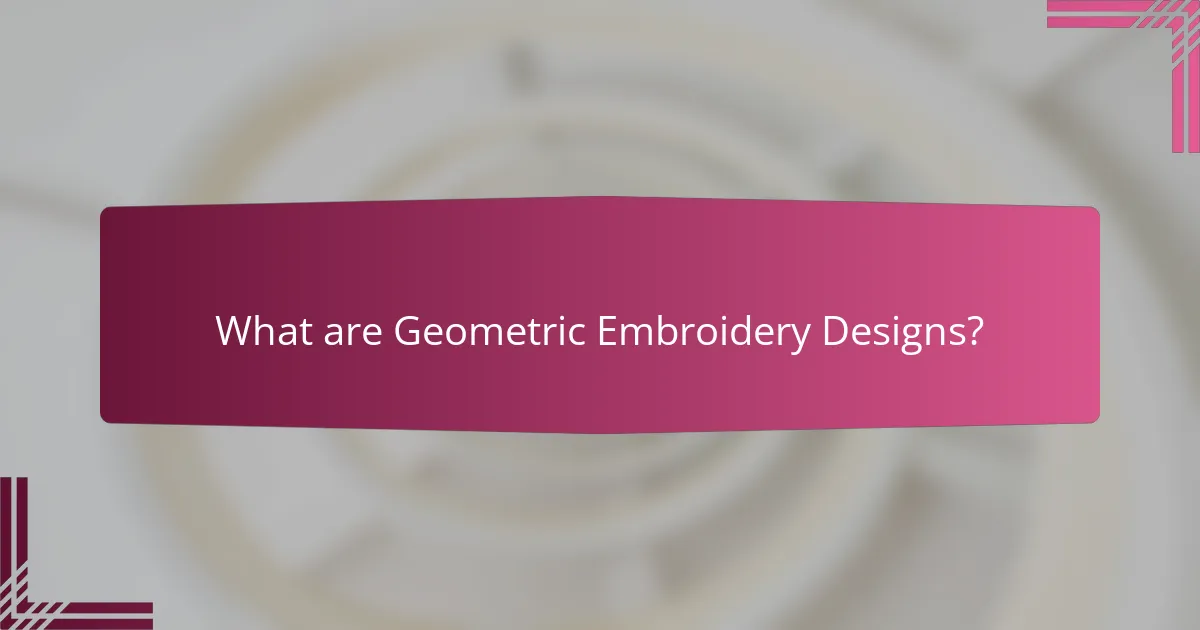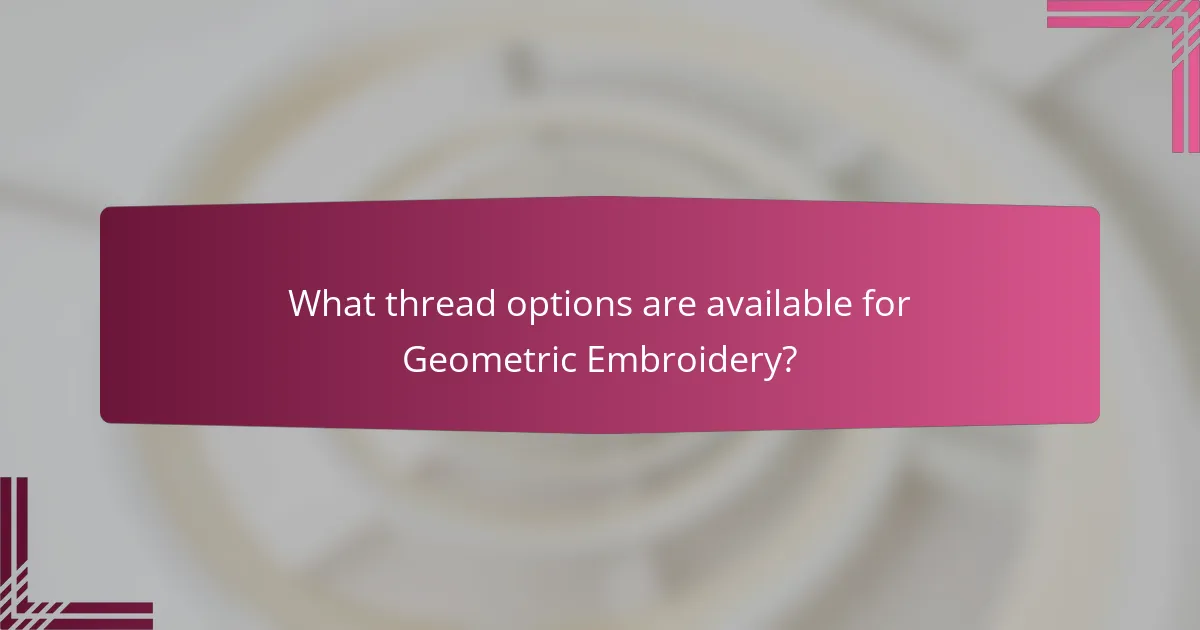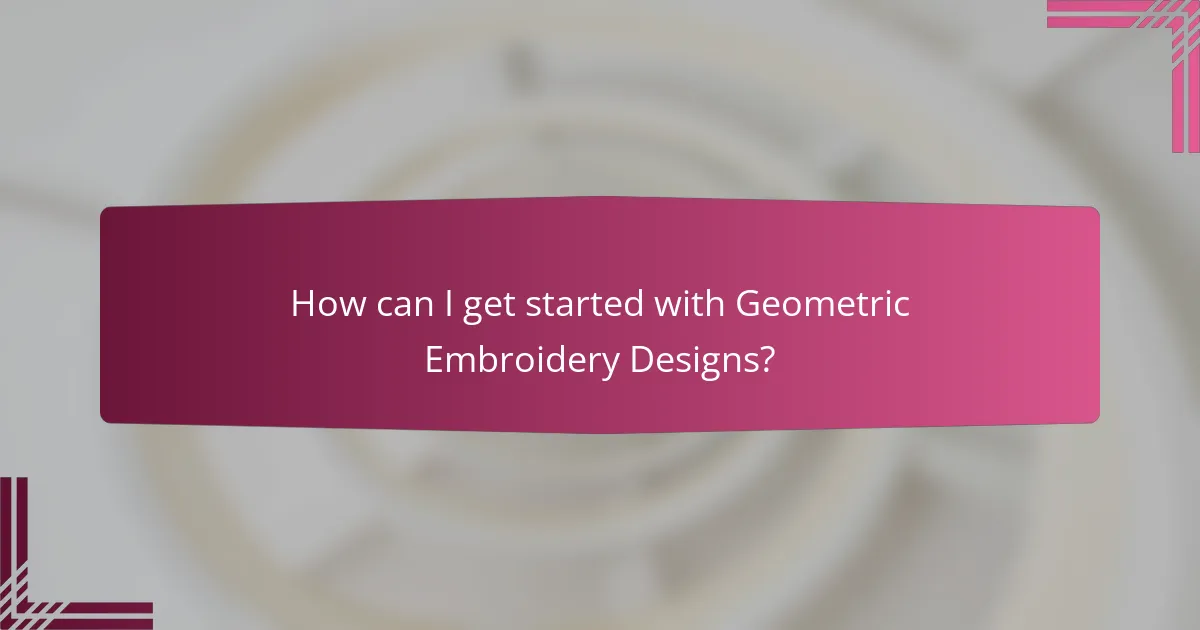
What are Geometric Embroidery Designs?
Geometric embroidery designs are patterns that utilize shapes such as squares, triangles, and circles. These designs emphasize symmetry and repetition. They often feature bold lines and vibrant colors. Geometric embroidery can be found in various textiles, including clothing and home decor. This style dates back to ancient cultures, showcasing its historical significance. The precision in geometric designs allows for intricate detailing. Many artisans use these designs for modern and traditional embroidery projects. Overall, geometric embroidery combines art and technique effectively.
How do Geometric Embroidery Designs differ from other embroidery styles?
Geometric embroidery designs differ from other embroidery styles by focusing on precise shapes and patterns. These designs typically feature angular lines and symmetrical forms. In contrast, other styles may emphasize floral motifs or freeform designs. Geometric embroidery often employs a limited color palette for clarity. This style is characterized by repetition and uniformity in its patterns. Unlike traditional embroidery, which may involve intricate detailing, geometric designs prioritize simplicity. This approach allows for a modern aesthetic, appealing to contemporary tastes. Geometric embroidery is often used in home décor and fashion, showcasing its versatility.
What are the key characteristics of Geometric Embroidery Designs?
Geometric embroidery designs are characterized by their use of shapes and patterns. These designs often feature straight lines, angles, and symmetry. They can include simple forms like squares and triangles, or more complex arrangements. The color palette is typically bold and contrasting, enhancing the visual impact. Geometric embroidery often emphasizes repetition and rhythm in its patterns. It is commonly used in modern textile art and fashion. The designs can be applied to various fabrics, adding texture and depth. Their versatility allows for integration into diverse styles, from traditional to contemporary.
Why are Geometric Embroidery Designs popular in modern crafting?
Geometric embroidery designs are popular in modern crafting due to their versatility and aesthetic appeal. These designs can easily adapt to various fabric types and crafting techniques. Their clean lines and shapes create a contemporary look that resonates with current design trends. Additionally, geometric patterns allow for creative expression while maintaining a structured form. Many crafters appreciate the simplicity of geometric designs, making them accessible for beginners. The rise of minimalist design in home decor has further fueled their popularity. As a result, geometric embroidery has become a favored choice for personalized gifts and home accessories.
What styles of Geometric Embroidery Designs exist?
Geometric embroidery designs exist in various styles, including modern, traditional, and abstract. Modern geometric embroidery features clean lines and minimalistic shapes. Traditional styles often incorporate cultural motifs and patterns. Abstract geometric designs emphasize creativity and unique interpretations of shapes. Each style utilizes distinct techniques and color palettes. The variety in styles allows for personalization in embroidery projects. These styles are popular in home decor, fashion, and textile art.
How can different patterns influence the overall design?
Different patterns can significantly influence the overall design by affecting visual interest and emotional response. Patterns create rhythm and movement within the design. They can establish a focal point or guide the viewer’s eye across the piece. Geometric patterns often convey structure and balance, while organic patterns can evoke feelings of softness and fluidity. The choice of pattern can also impact the perceived complexity of the design. For instance, intricate patterns may suggest sophistication, while simpler patterns can promote minimalism. In geometric embroidery, the arrangement of shapes and lines directly affects the piece’s harmony and cohesion. Thus, the selection of patterns is crucial in achieving the intended aesthetic and emotional impact.
What cultural influences shape various Geometric Embroidery styles?
Geometric embroidery styles are shaped by various cultural influences. Different regions have distinct patterns and techniques. For example, Middle Eastern geometric designs often reflect Islamic art principles. These designs emphasize symmetry and intricate patterns. African geometric embroidery showcases vibrant colors and tribal motifs. These motifs often tell stories or convey cultural heritage. Asian cultures, like those in India, incorporate geometric patterns in traditional textiles. This reflects their rich history of craftsmanship. Each cultural influence contributes unique attributes to geometric embroidery.
What are the essential fabric choices for Geometric Embroidery?
Cotton and linen are essential fabric choices for geometric embroidery. Cotton provides a smooth surface for clean stitching. It is widely available and comes in various weights. Linen is another popular option due to its durability and natural texture. It holds embroidery well and adds a unique aesthetic. Polyester blends are also suitable, offering strength and wrinkle resistance. These fabrics ensure that geometric designs maintain their shape and clarity.
How does fabric type affect the execution of Geometric Embroidery?
Fabric type significantly affects the execution of geometric embroidery. Different fabrics have varying levels of stability and texture. For instance, tightly woven fabrics like cotton or linen provide a stable base for precise stitching. This stability reduces distortion during the embroidery process. Conversely, stretchy fabrics like knits may cause the design to warp. The texture of the fabric also influences the visibility of the stitches. Smooth fabrics allow for cleaner lines, while textured fabrics can obscure details. Additionally, the weight of the fabric impacts the choice of thread. Heavier fabrics may require thicker threads for durability. Therefore, selecting the appropriate fabric is crucial for achieving the desired outcome in geometric embroidery.
What are the best fabrics for beginners in Geometric Embroidery?
The best fabrics for beginners in geometric embroidery are cotton and linen. Cotton is widely available and easy to work with. It has a smooth texture that supports clear stitching. Linen offers a slightly textured surface, adding interest to designs. Both fabrics are durable and can withstand repeated stitching. They also hold embroidery threads well, ensuring neat results. Additionally, these fabrics are forgiving for beginners, making mistakes easier to correct. Overall, cotton and linen provide a solid foundation for learning geometric embroidery techniques.

What thread options are available for Geometric Embroidery?
The thread options available for geometric embroidery include cotton, polyester, rayon, and metallic threads. Cotton threads are popular for their durability and matte finish. Polyester threads are known for their strength and resistance to fading. Rayon threads offer a shiny appearance and smooth texture. Metallic threads add a sparkling effect to designs. Each thread type serves different aesthetic and functional purposes in geometric embroidery.
How do different thread types impact the final design?
Different thread types significantly impact the final design of geometric embroidery. The choice of thread affects texture, sheen, and overall visual appeal. For instance, polyester threads offer durability and vibrant colors, enhancing design visibility. Cotton threads provide a matte finish, suitable for subtle designs. Metallic threads add shine and dimension, creating eye-catching effects. Each thread type contributes unique characteristics, influencing how light interacts with the design. The compatibility of thread with fabric also plays a crucial role. For example, thicker threads may require sturdier fabrics to maintain design integrity. Ultimately, the selected thread type shapes the aesthetic and functional aspects of the embroidery.
What are the pros and cons of using cotton versus polyester threads?
Cotton threads are soft, breathable, and environmentally friendly. They provide a natural look and feel to embroidery. Cotton threads are less prone to fading over time. However, they can be more prone to fraying and breaking under tension. Polyester threads are strong, durable, and resistant to shrinking and stretching. They offer vibrant colors that resist fading. Polyester threads are often more affordable than cotton. Yet, they may not provide the same natural look as cotton. In summary, cotton offers softness and natural aesthetics, while polyester provides strength and colorfastness.
How can thread thickness affect the appearance of Geometric Embroidery?
Thread thickness significantly impacts the appearance of geometric embroidery. Thicker threads create bold, pronounced lines and shapes. They enhance visibility and make designs stand out more prominently. Conversely, thinner threads yield delicate, intricate details. This can create a more subtle and refined look. The choice of thread thickness also influences texture. Thicker threads add dimension, while thinner threads offer a smooth finish. Color saturation is affected as well; thicker threads often appear more vibrant. Overall, the selection of thread thickness is crucial for achieving desired design effects in geometric embroidery.
What techniques can enhance Geometric Embroidery Designs?
Techniques that can enhance geometric embroidery designs include the use of contrasting colors, layering, and varying stitch types. Contrasting colors create visual interest and emphasize geometric shapes. Layering different elements adds depth and dimension to the design. Varying stitch types, such as satin, running, and fill stitches, can introduce texture and complexity. Additionally, using embellishments like beads or sequins can further enhance the overall look. These techniques are commonly employed by experienced embroiderers to elevate their designs.
How can layering techniques be applied in Geometric Embroidery?
Layering techniques in geometric embroidery involve creating depth by stacking different elements. This can be achieved by using multiple layers of fabric or thread. Each layer can feature varying colors or textures to enhance visual interest. For instance, an embroidered shape can be placed on a contrasting background fabric. Additionally, using different stitch types on each layer can add dimension. Layering can also involve overlapping shapes to create complex designs. This method is effective in adding richness to geometric patterns. The result is a more dynamic and engaging embroidery piece.
What role does color choice play in Geometric Embroidery techniques?
Color choice significantly influences the aesthetic and emotional impact of geometric embroidery techniques. Different colors can evoke specific feelings and convey various messages in embroidery designs. For example, warm colors like red and orange can create a sense of energy and warmth. In contrast, cool colors such as blue and green often impart calmness and tranquility.
The contrast between colors can enhance the visibility and complexity of geometric patterns. High contrast can make designs more striking, while analogous colors can create a harmonious effect. Color choice also plays a role in cultural symbolism. Certain colors may carry specific meanings in different cultures, affecting the interpretation of the embroidery.
Research indicates that color psychology affects viewer perception and emotional response. A study published in the Journal of Color Research and Application highlights how color influences mood and behavior. Therefore, selecting colors thoughtfully in geometric embroidery can significantly impact the overall effectiveness and appeal of the artwork.

How can I get started with Geometric Embroidery Designs?
To get started with geometric embroidery designs, first gather your materials. You will need fabric, embroidery thread, and needles. Choose a fabric that is suitable for embroidery, such as cotton or linen. Select embroidery threads in various colors for your designs.
Next, explore geometric patterns. Look for inspiration online or in design books. Begin with simple shapes like triangles, squares, and circles. Practice stitching these shapes on scrap fabric.
Familiarize yourself with basic embroidery stitches. Common stitches include backstitch, satin stitch, and French knots. These stitches will help you create your geometric designs effectively.
Finally, create your first project. Start small, such as a decorative patch or a hoop art piece. As you gain confidence, you can move on to larger projects.
What tools and materials do I need for Geometric Embroidery?
To create geometric embroidery, you need several essential tools and materials. First, a suitable fabric is required, such as cotton or linen. Next, embroidery thread in various colors is necessary for design versatility. An embroidery hoop helps keep the fabric taut during stitching. Scissors are needed for cutting thread and trimming fabric edges. A needle suitable for embroidery, typically a tapestry needle, is essential for stitching. Additionally, a water-soluble fabric marker can be used for transferring patterns onto the fabric. Finally, a design template or pattern guide assists in achieving precise geometric shapes. These tools and materials are fundamental for successful geometric embroidery projects.
How can I select the right patterns for my skill level?
To select the right patterns for your skill level, assess your current embroidery experience. Beginners should choose simple geometric designs with fewer colors and stitches. Intermediate embroiderers can handle more complex patterns with varied techniques. Advanced crafters may opt for intricate designs that require advanced skills and creativity. Resources like embroidery books and online tutorials can guide your selection. Additionally, consider your comfort with specific stitches and materials. Matching patterns to your proficiency ensures a more enjoyable and successful project.
What tips can improve my Geometric Embroidery skills?
Practice regularly to improve your Geometric Embroidery skills. Frequent practice helps build muscle memory and refine techniques. Start with simple geometric patterns to gain confidence. Gradually increase complexity as your skills develop. Use high-quality materials for better results. Quality fabric and thread enhance the overall appearance of your work. Invest time in learning different stitches. Mastering various stitches adds versatility to your designs. Study existing geometric embroidery works for inspiration. Analyzing professional pieces can provide valuable insights into techniques and styles. Join online forums or local groups focused on embroidery. Engaging with a community can offer support and feedback on your progress.
How can I troubleshoot common issues in Geometric Embroidery?
To troubleshoot common issues in geometric embroidery, first identify the specific problem. Common issues include thread breakage, uneven stitches, and puckering. For thread breakage, check the tension settings and ensure the thread is suitable for the fabric. Uneven stitches can result from incorrect needle size or type; replace the needle if necessary. Puckering often occurs due to fabric choice; using stabilizers can help mitigate this. Verify that the embroidery machine is properly calibrated and clean. Regular maintenance of the machine can prevent many issues. Each of these steps addresses specific problems, leading to improved results in geometric embroidery.
What resources are available for learning Geometric Embroidery techniques?
Online platforms offer various resources for learning Geometric Embroidery techniques. Websites like Craftsy and Udemy provide structured courses. YouTube hosts numerous tutorials from experienced embroiderers. Books such as “Geometric Embroidery” by J. Smith are also valuable. Additionally, social media groups and forums foster community learning. These platforms allow for sharing tips and techniques. Many resources emphasize hands-on practice to enhance skills. Access to diverse styles and patterns is also available through these channels.
Geometric embroidery designs are defined by their use of shapes such as squares, triangles, and circles, emphasizing symmetry and repetition. This article explores the various styles of geometric embroidery, including modern, traditional, and abstract, along with essential fabric choices like cotton and linen that enhance the execution of these designs. It also examines thread options, including cotton, polyester, and metallic threads, highlighting their impact on the final appearance. Additionally, the article provides insights into techniques that can elevate geometric embroidery, troubleshooting common issues, and resources for learning these skills effectively.
